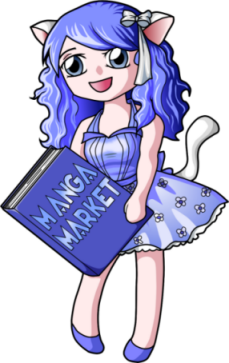What’s Manhwa?
What is Manhwa?
Manhwa is the term given to the korean comic-style, however more recently has been adopted to become a term for the South Korean comic books.
The Difference Between Manga and Manhwa
Although manhwa and manga share many similarities, it is often easy to distinguish between them. Some of the main differences are as follows:
–Manhwa books mostly read from left to right.
–The manhwa art style tends to put more emphasis on the eyes and face of characters.
–Character’s figures tend to have more realistic proportions.
–There is often a more frequent use of gradient “screen tone”.

An example of the manhwa art style, notice the emphasis on facial features, especially the eyes and lips.
A (very) Brief History of Manhwa.
The rise of the Korean manhwa industry has often been criticized as an attempt to follow the success of Japanese manga, however this is not entirely true, and manhwa have a distinct history of their own.
Manhwa’s modern origins are mainly political in nature, dating from the pre-war newspaper comics, criticizing and satirising the Japanese, who went on to occupy Korea in 1910. The manwha continued to portray anti-Japanese sentiments during this occupation, criticizing the administration’s treatment of the public, and calling for liberation.
After attempts to uproot Korean culture in the 1930s, manhwa was driven to more varied forms, often humorous, until the early 1940s. The Japanese authorities recognized manwha’s potential as a tool of propaganda, and adopted it to promote and justify Japanese rule, whilst encouraging people to enlist, with stories that glorified imperial Japan, and the ongoing war.
On August 15th 1945, Japan agreed to an unconditional surrender, leaving the Korean peninsula under the control of allied forces. The country was split in two, with the Soviet Union governing the North, and the United States the South. It was the United States that went on to revive use of manwha as propaganda once more, using it to promote anti-communist ideals across the nation, particularly during the Korean civil war (1950-53). Other war time manwha consisted of more emotional stories, that captured the pain and suffering caused by the conflict.
It was the 1960s that brought about manwha’s rise in pop culture. With the birth of “Manwhabangs” (Comic rooms, allowing people to read new releases for a small fee), manwha began to become more versatile, with many exploring sci-fi fantasy elements, whilst “Myongrang manhwa” (jolly comics), bore the brunt of public interest.
However, a military coup which brought Park Chung-hee to power in 1961 saw strict censorship take its toll on the industry. Rules prevented artists from drawing characters with mini-skirts, ribbons or any accessories that were viewed as showing extravagance, and it was viewed as “improper” for a boy and a girl to appear together in a single cut.
With Park Chung-hee’s assassination in 1979, the censorship laws were relaxed, and more artistic freedom was allowed, 80s creation, “Dooly” the mischievous time-travelling dinosaur being a prime example (although the artist later admitted that Dooly was only a dinosaur as censors refused to publish a child disobeying adults!). Over time, censorship became more and more relaxed, and the 90s progressed through romance to stories that expressed more daring themes such as feminism, transsexualism and homosexuality.
By the the late 90s, the true potential of manhwa was seen by the Kim Dae-jung administration, perhaps noticing the international potential through the popularity of manga, which saw the creation of government agencies to promote the industry.
The rise of the manhwa has been relatively unnoticed in the western world, whilst many popular manhwa exist, they are generally mistaken for their Japanese counterparts, or credited as imitations and attempts to infringe on their neighbour’s culture.
However, there has been a significant increase in manwha titles available in Europe in recent years, with a number of top American publishers (such as Dark Horse comics and Yen Press), adopting their own list of manhwa titles.
But it’s not just the West that is affected by manhwa, with its popularity in Asia leading to many successful live action film and TV adaptations, and spawning a number of successful video games.
Popular Manhwa Titles
– 11th Cat
–13th Boy
–Cynical Orange
-The Great Catsby
–Jack Frost
–Laon
–One Fine Day
–Ragnarok
Comments
10 Responses to “What’s Manhwa?”Trackbacks
Check out what others are saying...-
[…] At Manga-Market.com, tomnomnom joins the legions who attempt to explain “What is manhwa?” […]
-
[…] One Fine Day Author: Sirial Rating: 4/5 A manhwa, series of 3 […]
-
[…] One Fine Day Author: Sirial Rating: 4/5 A manhwa, series of 3 […]





This is very interesting – and you’ve tackled its history in once article. A great piece!
It was a pain. And I kept getting distracted by Football Manager and getting angry because my team wasn’t winning. >.>;;
one*
Reblogged this on Idiosyncratic Inklings and commented:
a style i like
Reblogged this on bananasai.
is tower of god not part of a manhwa? the picture above, nor the colorings or the characters is not similar to the manhwa that i have known. and i also thought noblesse is a manhwa since it cannot be an anime, neither is the tower of god.
They’re both technically manhwa webcomics (the key factor being that they are made by a Korean artist), this article just details some of the common stylistic differences that have existed between manhwa and it’s Japanese counterpart. Obviously with any artform, styles will evolve and these observations may become irrelevant…